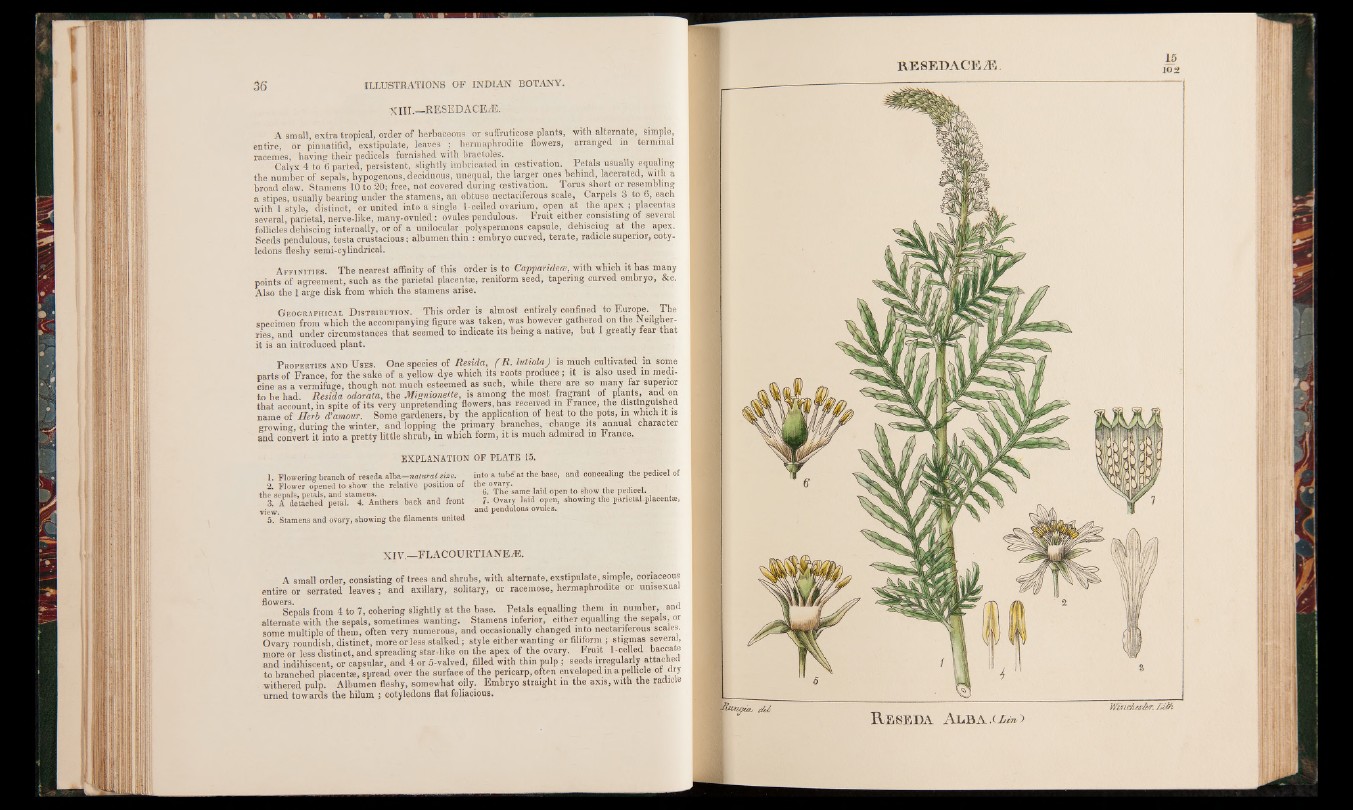
X III.—RESEDACEÆ.
A small, extra tropical, order of herbaceous or suffruticose plants, with alternate, simple,
entire, or pinnatifid, exstipulate, leaves ; hermaphrodite flowers, arranged in terminal
racemes, having their pedicels furnished with bractoles. i
Calyx 4 to 6 parted, persistent, slightly imbricated in aestivation. Petals usually equaling
the number of sepals, hypogenous, deciduous, unequal, the larger ones behind, lacerated, with a
broad claw. Stamens 10 to 20; free, not covered during cestivation. Torus short or resembling
a stipes, usually bearing under the stamens, an obtuse nectariferous scale, Carpels 3 to 6, each
with l style, distinct, or united into a single 1-celled ovarium, open at the apex ; placentas
several, parietal, nerve-like, many-ovuled: ovules pendulous. Fruit either consisting of several
follicles dehiscing internally, or of a unilocular polyspermons capsule, dehisciug at the apex.
Seeds pendulous, testa crustacious: albumen thin : embryo curved, terate, radicle superior, cotyledons
fleshy semi-cylindrical.
A ffin it ie s . The nearest affinity of this order is to Capparidete, with which it has many
points of agreement, such as the parietal placentas, reniform seed, tapering curved embryo, &c.
Also the 1 arge disk from which the stamens arise.
G eographical D istribution. This order is almost entirely confined to Europe. The
specimen from which the accompanying figure was taken, was however gathered on the Neilgber-
ries, and under circumstances that seemed to indicate its being a native, but I greatly tear that
it is an introduced plant.
P roperties and U ses. One species of Resida, ( R. lutiola) is much cultivated in some
parts of France, for the sake of a yellow dye which its roots produce | it is also used m medicine
as a vermifuge, though not much esteemed as such, while there are so many far superior
to be had. Resida odorata, the Mignionette, is among the most fragrant of plants, and on
that account, in spite of its very unpretending flowers, has received in France, the distinguished
name of Herb d'amour. Some gardeners, by the application of heat to the pots, in which it is
growing, during the winter, and lopping the primary branches, change its annual character
and convert it into a pretty little shrub, in which form, it is much admired in France.
EXPLANATION OF PLATE 15.
1. Flowering branch of reseda alba—natural size.
2. Flower opened to show the relative position of
the sepals, petals, and stamens.
3. A detached petal. 4. Anthers back and front
view. _
5. Stamens and ovary, showing the filaments united
into a tubd*at the base, and concealing the pedicel of
the ovary.
6. The same laid open to show the pedicel.
7. Ovary laid open, showing the parietal, placenta,
and pendulous ovules.
XIV._FLACOURTIANEiE.
A small order, consisting of trees and shrubs, with alternate, exstipulate, simple, coriaceous
entire or serrated leaves; and axillary, solitary, or racemose, hermaphrodite or unisexual
°W<Sepals from 4 to 7, cohering slightly at the base. Petals equalling them in number, and
alternate with the sepals, sometimes wanting. Stamens inferior, either equalling the sepals or
some multiple of them, often very numerous, and occasionally changed into nectariferous scales.
Ovary roundish, distinct, more or less stalked; style either wanting or filiform; stigmas several,
more or less distinct, and spreading star-like on the apex of the ovary. Fruit 1-celled H g
and indihiscent, or capsular, and 4 or 5-valved, filled with thin pulp; seeds irregularly attached
to branched placentae, spread over the surface of the pericarp, often enveloped in a pellicle ot dry
withered pulp. Albumen fleshy, somewhat oily. Embryo straight in the axis, with the radicle
urned towards the hilum ; cotyledons flat foliacious.
R e s e d a A l b a t a ^)
Wz/rirAeffor. LUh